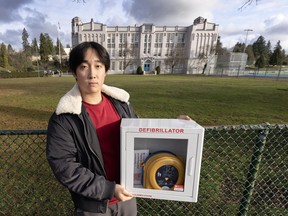Health
B.C. Schools Mandate CPR and Naloxone Training for Students

Starting this September, all Grade 10 students in British Columbia will be required to learn first aid, including CPR and the use of automated external defibrillators (AEDs), as part of their physical education curriculum. This significant policy change by the Ministry of Education aims to equip students with essential life-saving skills amidst growing concerns over health emergencies in schools. Additionally, all B.C. schools will be mandated to have medical kits that include naloxone for reversing opioid overdoses and AEDs for treating cardiac arrests.
The decision follows persistent advocacy from students and parents affected by tragic incidents involving cardiac arrest and drug overdoses. Notably, the initiative stems from the grief of friends and family members of those who have lost their lives, such as the case of Sidney McIntyre-Starko, a University of Victoria student who died after an overdose.
Tobias Zhang, a Grade 12 student at Point Grey Secondary, expressed relief upon hearing about the changes, stating, “It makes me feel like I can rest a little bit easier now. It’s nice to know that this device will be in schools, and we’ll all be a little bit safer in school.” Zhang and his classmates began advocating for AEDs after witnessing the collapse of a friend during a basketball tryout in 2022, only to discover that their school did not have an AED available.
Under the new curriculum, all public and private schools will ensure that CPR and AED training are included in the Grade 10 physical education classes. The Ministry confirmed that a ministerial order was amended last month to make it obligatory for secondary schools to have AEDs and naloxone kits by the end of 2025, with a deadline for elementary and middle schools set for September 2026.
The urgency for these changes was highlighted during a coroner’s inquest into McIntyre-Starko’s preventable overdose death, which recommended that CPR and naloxone training be included in school curriculums. Her parents, Ken Starko and emergency room physician Dr. Caroline McIntyre, have actively campaigned for similar educational reforms. McIntyre commended the new policy but emphasized the need for comprehensive education about the toxic drug crisis, which has become a leading cause of death for British Columbians aged 10 to 59. “Every child deserves to learn these basic, life-saving skills,” she remarked.
Melanie Cheng, president of the Vancouver District Parent Advisory Council, highlighted the importance of these measures. “It’s become an industry standard to have an AED at a recreation facility. Why not a school site?” she questioned, advocating for mandatory life skills training for students.
Vancouver school trustee Christopher Richardson supported the new requirements yet expressed frustration over the delayed implementation. “Let’s not wait until a coroner’s inquest demands this,” he said, noting that last year, the Vancouver school board had dismissed student requests for AEDs based on health advice, despite other districts already equipping their schools with the devices.
In January, the board reversed its position and sought $250,000 from the province to purchase AEDs for its schools. However, the recent provincial directives do not include funding, which means the Vancouver district will need to source the necessary funds independently.
Zhang and his peers have successfully raised nearly $14,000 to assist Vancouver schools in acquiring AEDs. He expressed a sense of accomplishment as they work towards making their schools safer. While the introduction of CPR and AED training is a significant step forward, Richardson underscored the importance of providing students with naloxone kits and training for overdose responses.
The ongoing toxic drug crisis in British Columbia has claimed over 16,000 lives since it was declared a provincial health emergency in 2016. The tragic circumstances surrounding McIntyre-Starko’s overdose underscored the urgent need for immediate medical responses in schools. During her incident, emergency services were contacted, but she did not receive naloxone for 13 minutes and CPR for 15 minutes, ultimately leading to her death from oxygen deprivation.
This implementation of CPR and naloxone training in schools marks a pivotal moment in the ongoing efforts to enhance student safety and responsiveness to health crises. As B.C. takes strides to equip its youth with vital skills, the hope remains that these changes will save lives and foster a safer school environment for all.
-

 Politics4 weeks ago
Politics4 weeks agoSecwepemc First Nation Seeks Aboriginal Title Over Kamloops Area
-

 World5 months ago
World5 months agoScientists Unearth Ancient Antarctic Ice to Unlock Climate Secrets
-

 Entertainment5 months ago
Entertainment5 months agoTrump and McCormick to Announce $70 Billion Energy Investments
-

 Science5 months ago
Science5 months agoFour Astronauts Return to Earth After International Space Station Mission
-

 Lifestyle5 months ago
Lifestyle5 months agoTransLink Launches Food Truck Program to Boost Revenue in Vancouver
-

 Technology3 months ago
Technology3 months agoApple Notes Enhances Functionality with Markdown Support in macOS 26
-

 Lifestyle3 months ago
Lifestyle3 months agoManitoba’s Burger Champion Shines Again Amid Dining Innovations
-

 Top Stories2 months ago
Top Stories2 months agoUrgent Update: Fatal Crash on Highway 99 Claims Life of Pitt Meadows Man
-

 Politics4 months ago
Politics4 months agoUkrainian Tennis Star Elina Svitolina Faces Death Threats Online
-

 Sports5 months ago
Sports5 months agoSearch Underway for Missing Hunter Amid Hokkaido Bear Emergency
-

 Politics5 months ago
Politics5 months agoCarney Engages First Nations Leaders at Development Law Summit
-

 Technology5 months ago
Technology5 months agoFrosthaven Launches Early Access on July 31, 2025





















